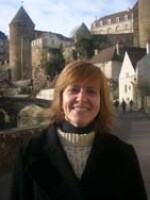AILSA CHANG, HOST:
In a forest in Burgundy, France, you can actually step into the past to discover the secrets of building a medieval castle. NPR's Eleanor Beardsley recently did and sends us this postcard.
(SOUNDBITE OF HAMMERING)
ELEANOR BEARDSLEY, BYLINE: Oh, my gosh. We're here at Guedelon. It's a castle they've been building for 26 years the original medieval way - with the old crafts - heritage crafts of stone carving and carpentry. And the workers are dressed in medieval costumes, except for one thing. They do wear modern safety boots.
SARAH PRESTON: This is a place you experience with all your senses. As soon as we walked on site, you smelled the woodsmoke. There's something so evocative about these sights and sounds.
(SOUNDBITE OF METAL CLANGING)
BEARDSLEY: That's Guedelon communications director Sarah Preston, my guide to this castle being built from scratch deep in a Burgundy forest.
(SOUNDBITE OF HAMMERING)
BEARDSLEY: Our first stop is the blacksmith shop, where 20-year-old Mattis Lacroix forges the tools needed to build the castle. Sparks fly as he pulls a cord which operates a giant bellows.
MATTIS LACROIX: (Speaking French).
BEARDSLEY: "Now the temperature is around 2,000 degrees," he says. "So the iron is soft and malleable, and I can make these nails." A group of fourth graders watches him pound the glowing red rods. Part of Guedelon's mission is pedagogy to teach school kids and train young craftsmen in heritage skills.
(Speaking French).
Would you like to do a job like this one day, I ask the kids.
UNIDENTIFIED CHILD #1: (Speaking French).
BEARDSLEY: "Yes," says one boy. "I've always wanted to be a stone carver."
UNIDENTIFIED CHILD #2: (Speaking French).
BEARDSLEY: "Me," says another, "I want to be a YouTuber."
Guedelon is self-financed from its 300,000 visitors a year. Twenty-four-year-old Simon Mallier makes furniture for the castle. He had a life-changing trip here as a boy.
SIMON MALLIER: I wanted to be a sculptor and work in the medieval world since I was 14, I think.
(SOUNDBITE OF BELL RINGING)
BEARDSLEY: The lunch bell rings out. Medieval records and manuscripts are used to reconstitute the tiniest detail of a real 13th century building site.
(SOUNDBITE OF HAMMERING)
BEARDSLEY: Stonemasons work near the quarry. Twenty-nine-year-old Tendra Schrauwen from Belgium, says Guedelon is one of the few places in the world you can practice the craft using traditional methods and old tools.
TENDRA SCHRAUWEN: Our job is to cut stones in the perfect geometrical shapes. So it's going to be windows, doors, chimneys, staircases. And it's stone by stone. Well, it's a teamwork. The stones are very heavy. It's very dangerous. So the most important thing is to work in teams.
BEARDSLEY: When Notre Dame cathedral caught fire in 2019, the phone in the off-site offices of Guedelon began ringing. That's because the castle is a known source for medieval building skills and knowledge, and those rebuilding Notre Dame needed advice.
(SOUNDBITE OF STONE SCRAPING)
BEARDSLEY: Painter Claire Piot is mixing colors in a stone bowl. She's painting the chapel and bedrooms of the castle. The colors are made from minerals found right here.
CLAIRE PIOT: So we use some ochres, some clays, some soils, charcoal, lime, things like that. And we can make 15 colors.
BEARDSLEY: The castle wall's cylindrical towers have slits for shooting arrows. The arrow loops, as they're called, are specifically spaced to avoid dead angles, says communications officer Preston.
PRESTON: These arrow loops are a bit like modern security cameras. They're a way of seeing out without being seen.
BEARDSLEY: Preston says many of the defense features at Guedelon were brought back from the Crusades, but it's a modest nobleman's castle, she stresses, not a royal castle.
PRESTON: So that means there are certain features which we can't include. For example, there won't be a drawbridge in front of this castle. Drawbridges existed in the early 13th century, but they were reserved for royal castles and the main gates of important towns.
(SOUNDBITE OF GEESE HONKING)
BEARDSLEY: Geese wander the grounds where there are projects to recreate the kind of village that would have existed beside a castle like this.
OK, do we need to be scared of these geese?
ANTOINE QUELLEN: Oui. Yes. It's better than dogs.
BEARDSLEY: That's gardener Antoine Quellen who works here two afternoons a week.
QUELLEN: We grow only medieval plants. And here we don't have tomato. We don't have potatoes because it comes from America - South America.
BEARDSLEY: Quellen says people ate a lot of grains. He's only planting indigenous seeds because they're hardier.
(SOUNDBITE OF HAMMERING)
BEARDSLEY: Everyone I talk to here has a deep love of nature. Thirty-year-old Charles Teixido is hewing a log with an axe. He's a carpenter apprentice at Guedelon after changing careers. He used to be a chef.
CHARLES TEIXIDO: I wanted to create something more durable. So now I'm still making something creative that will stay forever. What we're building here is going to stay maybe for 2,000, 3,000 years.
BEARDSLEY: Teixido says after working here, he wants to build energy-efficient housing. Guedelon's builders say this project will take many more years to finish. They hope shedding light on the secrets of 13th century castle construction will offer practical lessons for sustainable building in the future.
Eleanor Beardsley, NPR News, Guedelon.
(SOUNDBITE OF MUSIC) Transcript provided by NPR, Copyright NPR.
NPR transcripts are created on a rush deadline by an NPR contractor. This text may not be in its final form and may be updated or revised in the future. Accuracy and availability may vary. The authoritative record of NPR’s programming is the audio record.



